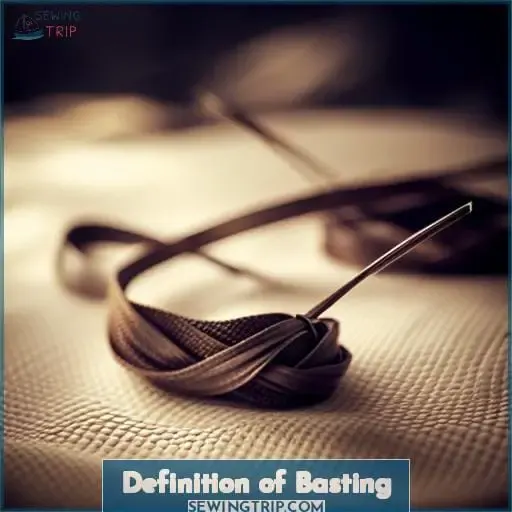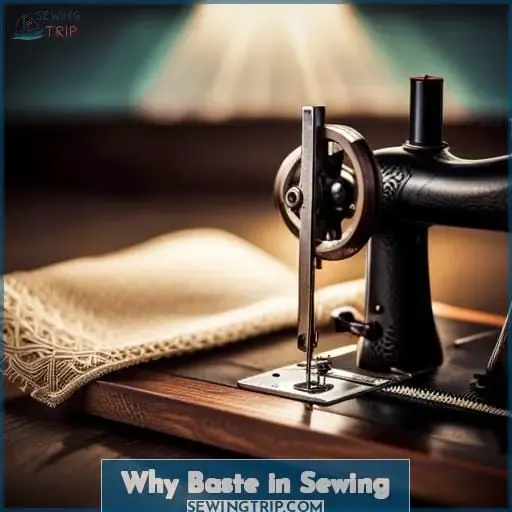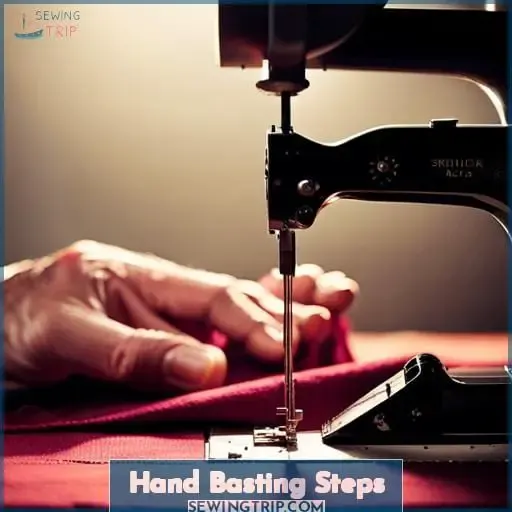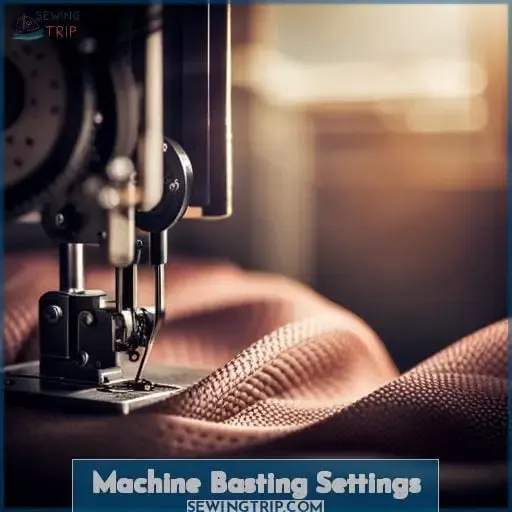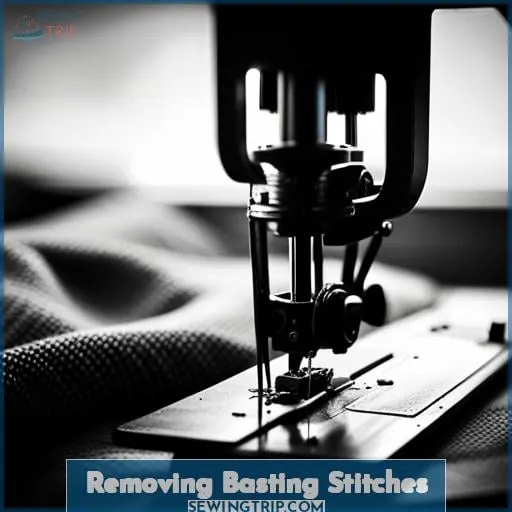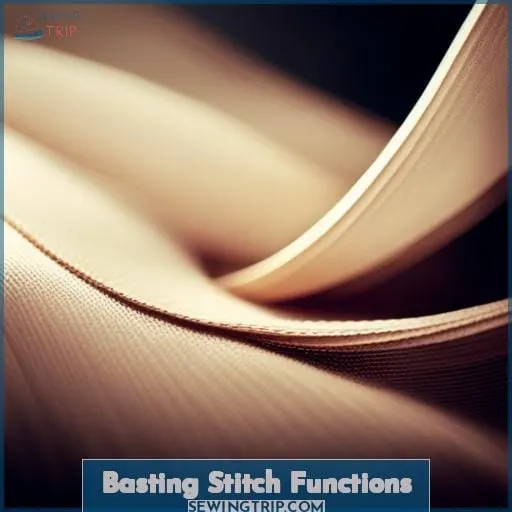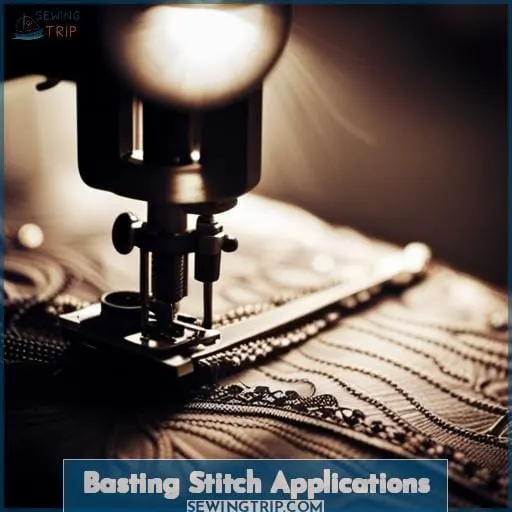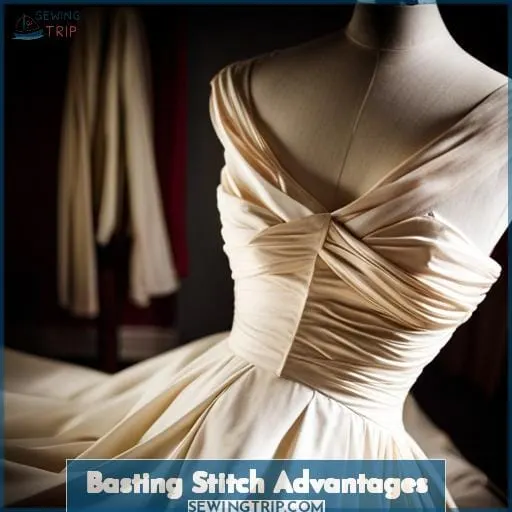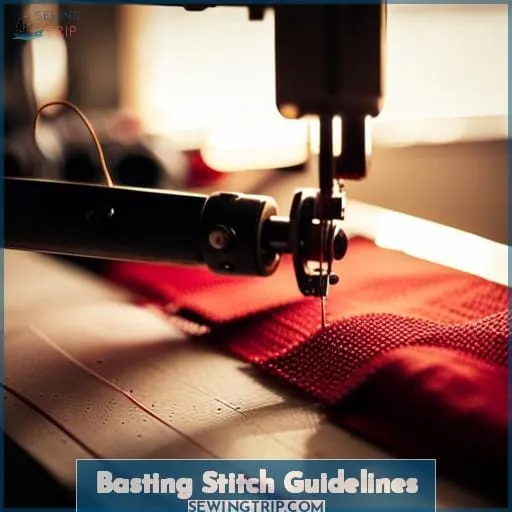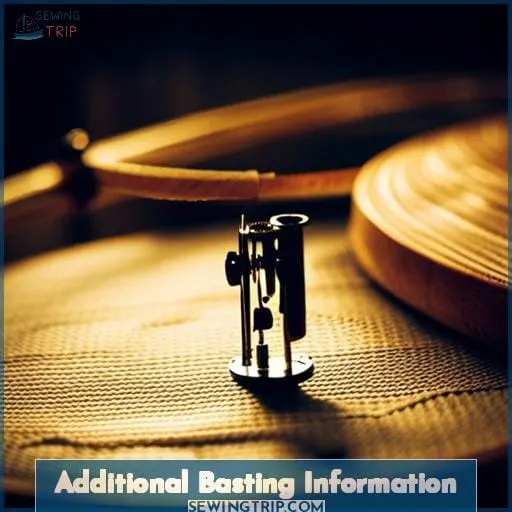This site is supported by our readers. We may earn a commission, at no cost to you, if you purchase through links.
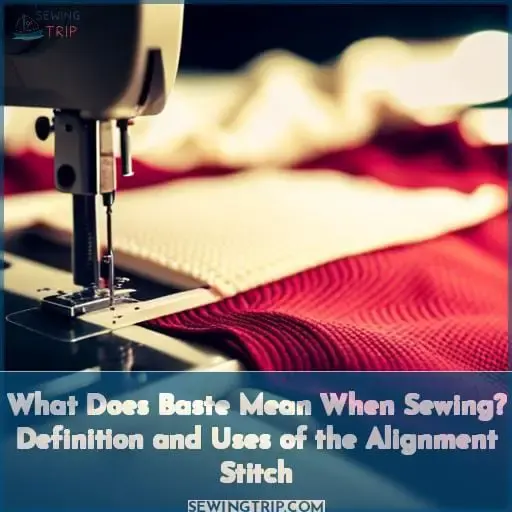 You’re probably familiar with basting a turkey for Thanksgiving.
You’re probably familiar with basting a turkey for Thanksgiving.
Did you know that basting is a technique used in sewing too?
Basting in sewing temporarily holds two pieces of fabric together before machine sewing.
It’s like a rough draft for your seam, allowing you to check the fit and make adjustments before committing to the final stitch.
Ready to up your sewing game?
Let’s dive into the world of basting!
Table Of Contents
Key Takeaways
- Basting stitches are long, removable stitches used to temporarily hold fabric layers together before permanent sewing.
- Basting allows for fitting adjustments, precise positioning, and prevents shifting during garment construction.
- Common uses of basting include fitting garments, aligning zippers, and installing zippers prior to permanent stitching.
- Basting stitches are removed gently after serving their purpose, using a seam ripper to lift threads from one side.
Definition of Basting
Basting is a temporary technique used in sewing to hold fabric layers together.
It involves using long, easily removable stitches to align and secure fabrics before permanent sewing.
Basting ensures proper positioning and prevents shifting during construction.
Temporary Stitches
Basting consists of temporary stitches used to hold layers of fabric in alignment during garment construction or quilting projects.
These loose, easily removable stitches allow for quick fitting adjustments and precise positioning of fabric layers before final sewing.
Basting benefits sewing projects by enabling smooth construction through proper alignment.
The temporary nature of these stitches means they can be easily removed after their purpose is served.
Whether hand basting or machine basting, these alignment stitches provide key precision in complex sewing work.
With some handy stitch removal tips, basting gives sewing and quilting projects a temporary but essential boost.
Alignment Method
Basting: An Overview
Basting stitches serve as temporary alignment for layers of fabric in sewing and quilting projects. You utilize the basting technique to precisely position pieces before final construction.
Basting stitches:
- Maintain stitching precision
- Avoid the need for excessive pinning
- Create removable bonds between layers
You apply basting to enable fabric stability, enhancing sewing efficiency when fitting garments or installing zippers.
Essentially, basting provides a removable alignment stitch.
Why Baste in Sewing
Basting serves some key purposes when sewing:
- To hold layers in place during fitting.
- To keep zippers aligned properly before final stitching.
Fitting
Basting stitches must be gently removed once their purpose has been fulfilled in the sewing project.
Use a seam ripper to lift the threads from one side.
Go slowly to avoid catching or tearing the fabric.
Remove stitches before pressing so they don’t set into the fabric.
| Removal Tip | Description |
|---|---|
| Use Seam Ripper | Lifts threads cleanly. |
| Work One Side | Prevents snags. |
| Remove Before Pressing | Avoids setting stitches. |
Zipper Installation
You baste zippers in place before final sewing to ensure proper positioning.
Pinning the zipper tape to the garment edge doesn’t guarantee it will stay aligned.
Basting tacks down the zipper so it stays perfectly positioned when you sew the final seam.
This alignment aid keeps the zipper straight, evenly spaced, and precisely where you want it.
Basting prevents frustration from a crooked zipper caused by shifting during sewing.
It’s an easy zipper prep step for accuracy.
Hand Basting Steps
Let’s move on to hand basting steps:
- Thread a hand-sewing needle with contrasting color thread.
- Align your fabrics and pin or clip them if needed.
- Begin basting with small, evenly spaced stitches.
Use a sharp needle and knot the end of your thread to start.
- Take care to precisely align and evenly space your basting stitches, keeping them small initially.
- This prevents puckering and maintains control of the fabric.
- As you work, make the stitches slightly larger, around 1⁄4 inch apart.
- Avoid pulling too tightly as you go.
Once basting is complete:
- Double check alignment.
- Remove any pins.
- Sew permanent seams.
- Gently remove the basting stitches with a seam ripper.
Hand basting allows for accuracy, fabric control, and custom stitch spacing.
Machine Basting Settings
You can set your sewing machine to create basting stitches by adjusting the stitch length to the longest setting, typically 4 or 5.
Use lightweight thread in both the upper thread and bobbin since it’s easier to remove.
When basting, avoid backstitching at the beginning or end so the stitches remain temporary.
Test your basting stitch length on a scrap of your project fabric first before sewing the garment.
Adjust the upper thread tension to be looser than normal. This prevents the stitches from being too tight and hard to remove later.
Consider using a lightweight needle as well.
The combination of lightweight thread, loose upper tension, long stitch length, and appropriate needle will result in nice, easy to remove machine basting stitches perfect for temporarily holding your project layers in alignment before the final sewing.
Removing Basting Stitches
Removing basting stitches requires gently loosening the long stitches with a seam ripper, working from one side of the fabric to the other while avoiding tearing the material.
Start at one end of the basting stitch line and carefully insert the point of the seam ripper under a few stitches, lifting upward to loosen them.
Continue moving along the line of stitching, loosening small sections at a time.
Take care not to snag or poke the seam ripper into the fabric layers as this can cause runs or tears.
If the threads feel stuck, use tweezers to gently grip and pull them free rather than risk damaging the fabric.
Always remove basting prior to pressing seams to prevent setting the stitches permanently.
With care, basting stitches can be efficiently removed, allowing you to move forward with your sewing project.
Alternatives like glue or tape basting are also available if removing stitches proves tricky.
Basting Stitch Functions
A basting stitch’s purpose is to temporarily secure your fabric layers together before performing the final sewing.
While straight machine stitching is the most common, alternative creative basting can add flair or functionality.
For specialty projects, use decorative hand stitches, washable fabric glue, double-sided basting tape, or fusible interfacing strips.
When precision is paramount, go the extra mile.
Try grid basting, diagonal basting, or zig-zag basting.
Compare basting and pinning to find the best approach.
Basting excels for slippery or loosely woven fabrics.
For stiff fabrics, stick with pinning first.
Stay flexible and troubleshoot as needed.
Adjust your technique, tools, and materials until your project layers feel secure.
With thoughtful basting, your end result will align perfectly.
Basting Stitch Applications
Applying basting stitches enables accurate zipper positioning prior to permanent sewing and holds quilt layers in alignment during the quilting process.
Decorative elements like piping, pom poms, and trims are hand or machine basted to one layer before sewing multiple layers together for home décor creations, ensuring proper placement.
For garment construction, basting assists fitting by temporarily securing layers so measurements are correct. It also facilitates zipper insertion by firmly holding the zipper prior to stitching for correct alignment.
Quilters rely on basting to prevent shifting of fabric layers during the quilting process.
Whether used for a precise zipper, decorative detail, fitting, or quilting accuracy, basting stitches are an essential preliminary step for flawless results and empower crafters with precision and control over their projects.
Basting Stitch Advantages
You’ll find using basting stitches makes the fitting process quicker and easier by eliminating the need to worry about catching all layers evenly.
Accurate Fitting.
Basting stitches ensure proper alignment during the fitting process for precision.
No Pin Holes.
Unlike pins, basting stitches don’t leave permanent holes that can compromise garment integrity.
Flexible Adjustments.
Basting stitches can be quickly removed and resewn for fitting adjustments.
Using basting stitches streamlines garment construction by securing layers and pieces temporarily before final stitching. They allow flexibility in fitting, room for error, and prevent frustration. With some thread and extra stitch length, basting gives you proper positioning without anxiety over perfect sewing.
Basting Stitch Guidelines
When creating basting stitches, use a stitch length between 3 to 5 mm, the longest your machine offers. This produces a loosely secured stitch to prevent distortion while temporarily bonding layers.
Select a contrasting thread color like neon yellow so stitches pop against the fabric.
Pin fabrics first to prevent shifting; place pins perpendicular to seams securing 3-4 inch sections.
Test compatibility on scraps; basting won’t hold slippery fabrics like satin or vinyl well.
If stitches pucker, lengthen stitch size. If seams shift, pin smaller sections.
Remove basting carefully with tweezers or seam ripper to avoid damaging permanent seams underneath.
Following these simple guidelines will have you effortlessly basting garments and quilts for accurate construction every time.
Now move onto additional handy basting tips to further expand your sewing skills.
Additional Basting Information
Your sewing machine’s user guide provides supplementary details for creating ideal basting stitches.
Consider basting alternatives like spray adhesive or fusible products for securing layers.
When removing basting, take care not to damage project layers.
Contrasting thread colors help spot basting but match regular project threads.
Ask sewing friends to troubleshoot tricky basting issues.
Explore creative big-stitch or decorative basting to temporarily tack quilts or embellish garments.
With practice, basting layers for accurate sewing and design flexibility gets easier.
Referring to machine manuals plus experimenting with basting options enhances your sewing skills over time.
Frequently Asked Questions (FAQs)
How do I baste lace or other delicate fabrics?
When basting delicate fabrics like lace, use silk pins sparingly.
Avoid spray adhesives which may damage the material.
Carefully hand baste with very loose stitches using lightweight silk or polyester thread in a contrasting color for visibility.
Remove basting gently to avoid snagging or tearing the delicate fabric.
Can I reuse basting thread for other projects?
No, don’t reuse basting thread.
It stretches and frays with use, compromising integrity.
Always use fresh, quality thread for permanent stitching to ensure durability.
What tools make removing basting stitches easier?
A seam ripper is essential, allowing you to gently loosen stitches without damaging fabric.
Tweezers also help grip tiny bits of thread.
Finally, a good light, such as a gooseneck lamp, illuminates your work area for precision and ease.
Take your time, be patient, and remove basting gradually.
Soon your pieces will be ready for the final sewing steps.
Do I need to press my project after removing the basting stitches?
Yes, you should press your project after removing the basting stitches. This helps set any seams and smooth out the fabric.
Be careful not to press directly on top of final stitching lines.
Is there an easy way to baste curved seams or edges?
For basting curves, patience pays.
Pin closely inside the seam allowance, then finesse your needle through the layers, easing as needed.
Remove pins just ahead of stitching to prevent distortion.
Take care around corners; precision leads to perfection.
Conclusion
Thus, ‘ere the final stitch, baste to align and fit.
This temporary method lets you preview precision before commitment.
Whilst pinning joins, basting allows adjustment – its removal leaves no trace.
So for flawless seams and perfect zippers, baste first.
This stitch keeps fabric together sans adhesion, benefitting both novice and veteran.
Indeed, proper alignment preempts perplexion.
Simply baste, assess, adjust, then sew.
This age-old trick spares frustration and fosters satisfaction.
What time and care at first saves many tears thereafter!
So baste on and sew forth happily whene’er fabrics meet.

